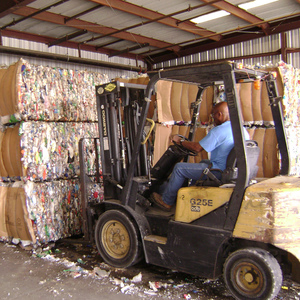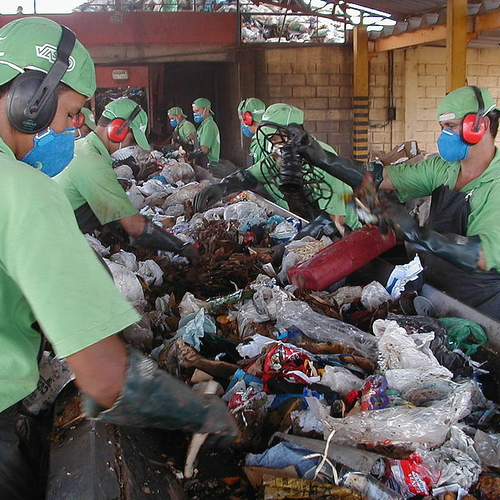
Jay W. Thomas, vice president of sustainability for the Vinyl Institute, sat down for an interview to shed light on their sustainability initiative, Vantage Vinyl. As the executive director of the Vinyl Sustainability Council, Thomas oversees a coalition of 75 companies spanning the entire vinyl value chain, from resin manufacturers to recyclers and retailers.
Vinyl in construction
Thomas outlined various vinyl or PVC products used in construction, including siding, roofing, windows, pipes, flooring, and more. He emphasized that the construction industry accounts for a significant portion of vinyl usage, with approximately 70% of vinyl manufactured being utilized in various construction applications, from municipal water systems to building construction. This is why vinyl is sometimes called the “infrastructure plastic.” And it is why its management—from production to disposal—needs scrutiny.
Given the construction sector’s heavy reliance on vinyl materials, its recyclability has been one point of scrutiny, particularly among environmentally conscious builders. Thomas acknowledged that while recycling efforts have made strides, there’s still much room for growth, especially post-consumer recycling. Some have criticized plastic recycling efforts as nothing more than eco-marketing i.e., greenwashing, given how little plastic is actually collected and repurposed.
However, Thomas points out that the industry is investing significantly to increase recycling volumes. In 2022, the industry recycled 1.3 billion pounds of vinyl, with more than 73 million coming from post-consumer sources. Challenges arise when dealing with mixed materials, as sorting and separating adds cost and complexity. While recycling vinyl products is feasible, it often requires dedicated collection systems, effective sorting processes, and access to suitable recycling facilities to ensure efficient and sustainable outcomes.
Here, the construction industry can play an essential role because the PVC used in building materials is of high quality, and generally, a single plastic, such as a PVC pipe, rather than a mix of plastics as you find, for example, in a bicycle helmet. The construction industry also produces large quantities of vinyl waste, such as tearing off old vinyl siding to replace the cladding, so there’s enough material to incentivize the recycling industry financially. For manufacturers to promote recycled content, they must have scrap vinyl to recycle. Until recently, the supply was not consistent enough for manufacturers to incorporate post-consumer recycled material. The Vinyl Institute set an industry-wide goal to increase recycling rates, aiming for a 15% increase by 2025. This means that you will see more products promoting post-consumer recycled content.
During our conversation, Thomas detailed the origins of the recycling initiative within the Vinyl Sustainability Council, which began in 2016. The council identified recycling as one of its key focus areas, alongside health and safety improvements and emissions reductions. In 2023, the council launched a grant program to accelerate post-consumer recycling efforts by awarding grants for new initiatives. Major resin manufacturers, including Shintech, Westlake, Formosa, and Oxy, collectively invested $3 million into the program. In the first year, 16 projects received grants totaling $1.7 million, covering a range of efforts from expanding pilot programs for vinyl siding recycling to repurposing vinyl billboards for disaster relief and supporting advanced recycling research at universities.
One of the most successful programs funded was the Vinyl Siding Institute’s Revinylize, which has already completed a pilot phase and launched the first industrywide effort to establish the logistics necessary for a meaningful improvement in the supply chain from siding contractor to recycler. At first, VSI seemed cool to the idea of recycling. But over the years, attitudes changed, and the siding manufacturers VSI represents developed a keen interest in the area. VSI’s recycling program has become one of the industry’s most significant post-consumer recycling initiatives.
A recycling collaborative
The recycling initiative launched in late 2023 with a $100,000 grant from the Vinyl Institute. VSI set up a web platform to sign up recyclers and collection sites to map their locations. You can use it to look up a location to drop material. The program just started in Cleveland, Ohio, so you will see a representative sample of participating suppliers in this area. The idea is to expand this model to all 50 states and 10 provinces in Canada.
“I’m spearheading the program, managing its development, and recruiting people to get involved,” explained Matthew Dobson, Vice President of VSI. “It’s North American focused, and we’ve identified about 20 strong recyclers we want to bring into the program,” he said.
There are two types of recyclable vinyl: rigid and flexible. “On the rigid side, you have pipe, decking, railing, windows, and siding. These are the materials we’re focused on.” Other programs focus on flexible vinyl, and there may come a day when construction sites segregate waste into a few small containers or a single container with dividers. Reflecting on the program’s inception and why it’s only now getting started, Dobson highlighted the timing. “Fifteen years ago, this project would not have the success it has today because we weren’t at a point where many products were at the end of their useful life,” he explained.
In the case of vinyl siding, the useful life is about 50 years. Twenty years ago, vinyl siding had about 40% of the cladding market, which means that in the next three decades, all those homes will have to be reclad, “showing the potential size of the market,” Dobson said.
He emphasized that recycling technology exists, and with almost all manufacturers wanting to market materials with recycled content, the demand exists, too. What VSI needs is a way to spread the word, get people signed up, and provide contractors and consumers with an easy way to find places to take construction scraps or tear-offs. The industry has decided to focus on recycling because it is the most well-understood sustainability concept. Dobson remarked, “Everybody understands recycling, and recycling is less energy intensive than virgin material extraction, so recycling will lower the carbon footprint of rigid vinyl use too.”
As we discussed upcoming developments, Dobson became animated, stating, “We’re thrilled to welcome Unibel, the prominent Pipe association, as one of our association sponsors.” VSI is collaborating with the Window and Door Manufacturers Association to discuss integrating vinyl window recycling into the program. This aligns with the practices of numerous residential companies involved in siding and window replacements.
“Revinylize will implement and organize this infrastructure and help people to understand how they can participate,” Dobson said. As an immediate goal, “It’d be great to get into, like, ten geographic markets this year,” he said, adding: “We aim to recycle five million pounds of rigid vinyl during 2025 due to this program.”
When asked about the significance of this goal relative to industry production, Dobson explained, “It’s just a goal that we set that aligns with the Vinyl Institute’s goals for recycling. So, it’s just a starting point. It’s not relative to anything, honestly.”
Nonetheless, Dobson expressed confidence in the program’s potential impact. Dobson’s vision for the Vinyl Siding Institute’s recycling program is continuous growth and the normalization of collecting and using recycled materials within the industry. “Through strategic planning and collaboration, Revinylize aims to drive significant change in the handling and repurposing of vinyl materials,” Dobson concluded.
Recycling vinyl roofing
In the flexible vinyl category, recycling of vinyl roofs is measured in square feet but could be in acres. For example, Target is a retailer with sustainability initiatives that include recycling its PVC roofs. Some individual PVC roof manufacturers have implemented the collection of roof tear-offs and incorporated post-consumer recycled content in their new membranes. As an industry, the Chemical Fabrics and Film Association (CFFA) has a specific division, the Vinyl Roofing Division (VRD), spearheading efforts to increase PVC roof recycling.
In collaboration with the Vinyl Institute, through their VIABILITY grant program, the CFFA VRD matched the VIABILITY grant funding to advance recycling efforts for PVC roofing materials and hired industry experts Richard Krock and Brian Whelan to run the program. Although still in the initial phases of development, the concept is “Pathway to Zero Production Waste and Scrap,” a term coined by the CFFA VRD to encapsulate the goal of minimizing waste throughout the PVC roofing production process.
Like other vinyl recycling programs, the challenge begins not at the recycling center but winning over hearts and minds. “There are many obstacles,” explained Krock. “The primary obstacle is a general lack of understanding that the PVC roof can be recycled. Many contractors put a roll-off dumpster alongside the building, and everything off the roof goes into the dumpster. Not all contractors are thinking about recycling. Roof specifiers and building owners are only now beginning to advocate for greater sustainability in the use of vinyl and learning about how the life of a vinyl roof membrane can be recovered and revived into new products.”
In a recent survey, CFFA found that 83% of the roofing contractors said they were interested in recycling, and they felt that 72% of their building-owner customers would be interested too. “We think the industry is ripe for getting this message out to begin to recycle PVC roof membranes in a bigger manner,” said Krock. However, the best practices must be addressed.
“Roofers will randomly tear off a roof and throw it into a dumpster, but to recycle it, they have to tear it off in a manageable size. Instead of randomly ripping and tearing, we’re educating roofers to slice the vinyl sheets in a fashion to roll them up in 50-ft. lengths, 3 ft. or 4 ft. wide, and place the material into wooden crates or gaylord boxes so the recycler can pick it up and haul it away,” explained Krock.
The low-hanging fruit in PVC roof recycling comes with large corporations that comply with ESG (Environmental, Social, and Governance) reporting requirements. Recycling an old roof when they replace it offers an opportunity to signal good environmental citizenship. Overall, the PVC roof recycling program has grown 48% between 2022 and 2023. To measure the initiative’s success, CFFA monitors the number of projects as well as square feet and pounds of PVC membrane recycled. “We believe the number of projects is more indicative of the engagement of the value chain,” said Krock.
The agenda for 2024 includes developing the brand, starting with a catchy name for the recycling initiative, a web portal for the program, and contacting recyclers to sign up. “We aim to provide talking points for manufacturers, suppliers, specifiers, and roofers to mention the program on every PVC re-roofing job. The more we talk about it and develop these ideas, the more people will do it,” said Whelan.
When I asked Whelan and Krock about their program’s future, they discussed “a pathway to zero,” meaning no PVC roofing production waste goes to the municipal landfill. “A pathway is not the destination,” Whelan clarified. “So, we aim for zero while acknowledging we may fall short a percentage point or two.”
In conclusion, he added, “In parallel, we will raise the awareness of the ability to recycle a PVC roof at the end of its service life and we strive to make recycling the norm rather than the exception.”
Why care
The journey towards widespread PVC recycling represents a step in the broader movement toward sustainability in the construction industry. Green builders understand the critical role that responsible waste management plays in preserving our environment for future generations. Even if you do not use some of the products mentioned, you use others. As the industry that consumes the lion’s share of vinyl, supporting these efforts makes good sense. The accusation that manufacturers do this as a marketing effort to appease environmentally conscious consumers is a testament to our successful efforts in promoting consumer demand for green buildings.
_______________________________________________________________________
Fernando Pagés Ruiz is a builder and an ICC-certified residential building inspector active in code development. Images courtesy of author, except where noted.
Weekly Newsletter
Get building science and energy efficiency advice, plus special offers, in your inbox.















16 Comments
Thanks for the informative article.
It's amazing (and depressing) to me that recycling these materials is only now gaining traction.
Indeed, but it is good that it is finally gaining traction--in no small part due to consumer demand for guilt-free products, like cage-free eggs and fair-trade coffee.
20+ years ago I had vinyl salesmen trying to convince me to specify vinyl products, despite our firm's well known "green" reputation, by claiming that they had made such great strides in recycling the product. I never took the bait.
Vinyl is very problematic at every stage of its life cycle, from resource extraction to disposal.
I'm glad to see them at least going through the motions to try to recycle the stuff. But the best thing we can do is not use it in the first place.
The article's point is that you use it now. You cannot avoid it. Even if you build log cabins, vinyl is in the new chinking systems. What the industry is trying to convey is that all kinds of vinyl are recyclable, windows, floors, roofs, pipes, and, of course, siding--which, incidentally, has a lower carbon footprint than many other options. Attitudes exist, but facts sometimes contradict them. You don't have to use vinyl siding, but the article is not about that.
It's a hugely profitable industry that has managed to entrench itself deep into our construction industry. It has a tremendous amount to lose if consumer sentiment turns against it. So it will say and do whatever it takes to protect those profits.
I remain skeptical. And I will continue to remove it as much as possible from my projects, as well as attempt to educate people on its problems and the alternatives.
"Attitudes exist, but facts sometimes contradict them."
That's simply insulting.
JGSG,
"Some have criticized plastic recycling efforts as nothing more than eco-marketing i.e., greenwashing, given how little plastic is actually collected and repurposed."
Some go further than that: https://www.euronews.com/green/2024/02/16/plastic-industry-knew-recycling-was-a-farce-for-decades-yet-deceived-the-public-report-rev
Hi jollygreen. I'm not sure about the insult. Many people have an aversion to vinyl in specific applications and not others. The facts have to do with trade-offs. Many prefer fiber cement to vinyl siding, even though the carbon footprint of fiber cement is much higher--this is a fact. But even if the original argument is about the environment, these folk will continue to use fiber cement--they like it better. That's an attitude. Do you dislike plastic in the vinyl tube used for transfusions? Do you dislike it intensely on the dashboard of a favorite car? Do you own a laptop or iPad--these are full of vinyl. The industry is trying harder to recycle this stuff. Maybe the industry needed to do more back when, but now they are doing more. Should we disparage the effort? Or are we also the cause of it as consumers of so much vinyl? And if not vinyl, do you believe glass or paper is better? I recommend a book on material science; when comparing impacts, plastic is not the worst; it's just the most disparaged right now. For another perspective, visit https://plasticsparadox.com/.
"Do you dislike plastic in the vinyl tube used for transfusions?"
I was writing with respect to the industry in which I work and which is the focus of this website, the construction industry. I was not writing with respect to the medical equipment industry. I would think that would have been obvious.
If vinyl saves lives in hospitals and its the best material for the job, then great, use it there.
If there are suitable substitutes for it in laptops and car interiors then I'd happily purchase items made with those alternatives. I don't know those industries well enough to know whether the alternatives exist.
We don't need to replace every house window in America with vinyl. Nor do we need to coat every exterior surface with it in the form of siding. Nor do we need to use it in many other products inside our home. The consequences are negative and there are excellent alternatives.
It's good if the industry is actually trying to make recycling work this time.
They obviously didn't try hard enough 20+ years ago.
And if I can avoid specifying it and seeing it installed on my projects then it doesn't even have to be recycled because it wasn't used in the first place.
Re. fiber cement siding - every product has its environmental impact. Yes, they need to be weighed against each other. Carbon footprint is important but not the only measure. Amongst siding materials my first choice is usually FSC certified cedar lap siding. That's generally near the top of the list in terms of environmental and human health.
My "attitudes" are based on FACTS studied over a 40 year experience in the industry. They're not just based on what I "like".
We need a mushroom that can feed on vinyl and then let it loose on our landfills...
russellchapman,
Plastic eating bacteria:
https://www.theguardian.com/environment/2023/sep/28/plastic-eating-bacteria-enzyme-recycling-waste
NPR had a similar news story. I sent it to the Vinyl Institute and the Polymeric Exterior Products Association (PEPA) for comment. Only PEPA replied. I pasted what they said below:
Fernando, Thanks for the opportunity to comment on the below information from the NPR article on plastic waste. There are a few items I’d like to make note of that make this article misleading:
• Vinyl, as a material, is not solely made from fossil fuels, but its majority ingredient is salt, so to think plastics are just fossil fuel based is not correct
• The statements made in this article are decades old. Information from 30-40 years that was true then may not be true now. We have evolved since then to a sustainability-focused society, including industry, and recycling has been identified as a top priority by most
• Recycling in the vinyl industry has been going on for decades, contrary to the statement from the article, post-industrial recycling has enabled the industry to be very clean in the manufacturing setting
• Post-consumer recycling is next, and we know it’s possible based on the pilot program we managed over the past few years in Ohio
• As rigid vinyl comes to a useful end of life, it can easily recycled back into new products, and there will be more supply than in the past, so this creates a much more feasible opportunity
• Part of recycling includes a lower energy intensity, which means recycling has less carbon impact than extraction of raw materials. There’s a real incentive here on the carbon end to this, and the industry understands this
• The bottom line is the industry is about solutions, including recycling and landfill diversion
• Finally, from the carbon footprint perspective, many plastic products have a lower carbon impact than alternative materials, and for that reason alone, a push towards not using plastics could take us further down the path of unsustainable practices relative to climate change
Matt Dobson, Vice President.
Fernando,
I don't see the use of simply publishing industry talking points without examining them. They may be right, but surely journalism is not simply being credulous about everything we are told?
Malcolm,
You would like evidence to back up a claim from a group of people telling you something is true? That is a clear shift from you. You don't want to be "advice resistant" , do you?
Well I support your new science based philosophy 100%. Good job!
The problem is how do you keep it there. If it escapes and starts attacking houses then vinyl really becomes an environmental nightmare.
Great points DC & Malcolm! I hope this is the breakthrough the industry needs to round the corner, since the material isn't likely going away anytime soon.
Funny. Excellent basis for a science-fiction dilemma!
Log in or create an account to post a comment.
Sign up Log in